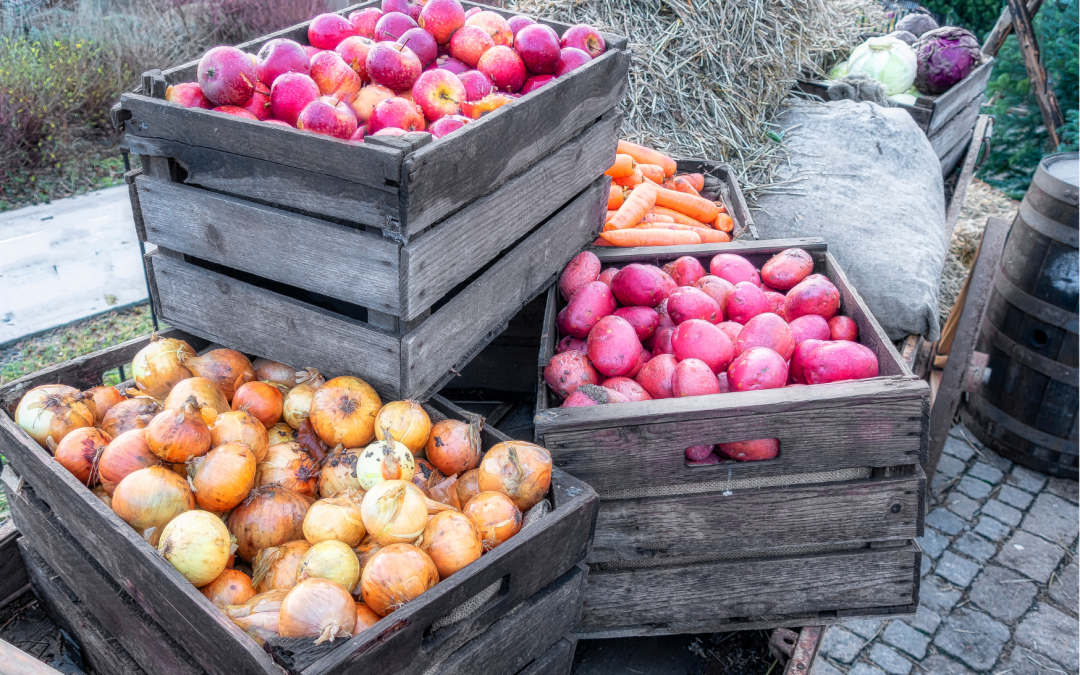The simple act of eating seasonally can be a beautiful reminder of the cycles of the seasons and how our bodies respond. Embracing each season brings with it so many benefits, not only for our taste buds but also for our health, the environment, and local communities. Check out some of the advantages we can think of…
Full of Flavour
When allowed to ripen in their natural environment, fruits and vegetables harvested in-season have much more flavour compared to when they are picked early and allowed to ripen later. The natural harmony between sunlight, temperature, and soil conditions during the growing season contribute to the enhanced flavours. Nothing compares to the taste of produce freshly picked from your own garden or local farms during its peak season – the taste of a peach still warm from the sun, a sun-ripened tomato straight from the vine, super sweet and tender peas or crunchy carrots and beans… Kids often have an affinity to sweet things, so sharing the experience of fresh, ripe produce can help encourage them to try new things. Fruit picking experiences, or farm tours are great fun too!
So Much Nutritional Goodness
Seasonal fruits and vegetables are harvested at their peak ripeness, resulting in superior nutritional content. To ensure that people have greater access to certain fruits and vegetables, some varieties can be picked very early in the ripening process, then stored in cold storage so that they gain colour more slowly. However, some vitamins, such as vitamin C and folate, can significantly decrease during prolonged storage (not so for snap frozen vegetables which has been shown to maintain these vitamins, so they’re still a great choice). By consuming produce soon after harvest, we ensure a higher intake of essential vitamins, minerals, and antioxidants that support our immune system and overall health.
Reduce your Footprint
Choosing local and seasonal foods where possible for you and your family reduces the demand for out-of-season produce. Fruit and vegetables that are sold out of season have usually been sourced from warmer climates, which often requires long-distance transportation from interstate or overseas or requires specialised and energy-intensive growing or storage methods. The additional energy, resources and waste (including air pollution) contributes to greenhouse gas emissions, but by supporting local, seasonal produce, we help reduce our carbon footprint and promote sustainable agricultural practices that benefit the environment.
Supporting Local
Eating with the seasons may give you the opportunity to connect with your local farmers. By purchasing seasonal foods from farmers’ markets, we directly support local economies and small-scale farmers. This support ensures the preservation of farmland, promotes crop diversity, and enhances food security within communities. Bringing your kids along to markets gives them the opportunity to ask questions about where their food comes from, allowing their natural curiosity and building their connection and interest in the food they eat.
Bang for your Buck
Seasonal produce tends to be more abundant during its peak harvest, leading to lower prices for consumers. Buying local and seasonal foods can save consumers money, as the costs associated with transportation and storage are reduced. Eating seasonally can be a budget-friendly way to enjoy nutritious and delicious foods. Finding your local Food is Free group in your community, or joining local food swap group can help save money, grow connections within your local area, offload some of your own excess produce (if you grow your own or wish to share bulk purchases), try new fruits or vegetables not available in stores or maybe swap some new recipe ideas!
Save your Precious Time
Food delivery options such as fruit and vegetable boxes can often save time with subscription options that mean you don’t have to choose or shop for your fresh produce. These subscription services mean that local farmers can supply yu with fruits and vegetables that are at their most fresh and abundant best, so there is less waste. You might end up with some ‘ugly’ or misshapen items that would have normally gone to waste not being preferred by larger shops that prioritise uniform produce.
Some delivery services include Funky Food, Farmers Pick and Good and Fugly.
Get Creative
Getting a surprise fruit and vegetable haul from a subscription service or mixed box from a delivery service, or simply committing to trying a new fruit or vegetable or recipe a week gets those creative juices flowing and can help get kids more connected and interested in the food they eat. Having a giggle at a carrot with two ‘legs’ or a capsicum that has grown a ‘nose’, a giant beetroot or a wonky cucumber can sometimes breakdown challenges to trying new things.
As different fruits and vegetables become available throughout the year, we have the opportunity to try new recipes, experiment with unique ingredients, and discover fun flavor combinations.
Connect with Nature
Eating seasonally fosters a greater connection with the natural world. As we tune into the cycles of nature and the changing seasons, we become more mindful of our food choices and their impact on the environment. We can start to connect with the foods that are abundant in certain seasons and benefit from their nutrients and cooking methods that bring out the best qualities. Bright orange and yellow carrots, sweet potatoes and pumpkins or dark leafy greens that are at their best over the cooler months provide vitamins A and C for immune function and root vegetables are great when cooked low and slow making them easier to digest when the weather is cold and or bodies are trying to keep warm. Fruits and salad vegetables that are delicious raw or lightly cooked are at their peak in summer when we crave lighter foods over warmer days. And the anticipation and gratitude of waiting until your favourites are back in season is exciting too… the first smell of a ripe mango is the first real sign of summer that I love to celebrate!
What’s your favourite seasonal memory?
Sign up to our newsletter (at the bottom of the page) to receive your free Seasonal Shopping List each month which includes a monthly list of what’s in season so you can scan and add to your shopping list and plan your seasonal menu!

